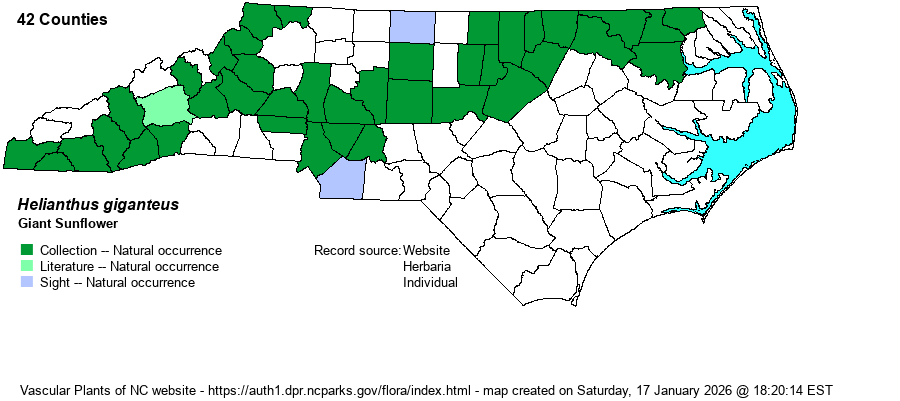| Author | L. | |
| Distribution | Low Mountains, Piedmont, and the northwestern Coastal Plain. Not found (yet) south of Bertie and Halifax counties in the Coastal Plain.
N.B. to MN, south to northern GA, TN, and IL. | |
| Abundance | Fairly common in the northwestern Coastal Plain and northeastern Piedmont; infrequent to fairly common over the rest of the Piedmont and Mountains. This is an odd abundance pattern in the state, as very few species seem to be most numerous in the inner, northern Coastal Plain and adjacent Piedmont than anywhere else in the state. | |
| Habitat | Moist to wet soil of damp meadows, forest borders, seepage slopes, roadsides ditches, and moist thickets. Strongly favors full sun and damp conditions, though is not a marsh species. | |
| Phenology | Flowering and fruiting late July-October. | |
| Identification | True to its name, Giant Sunflower grows 3-9 feet tall, with a coarsely hairy stem, lance-shaped leaves that reach 7 inches long and are rough on the upper surface and that have very short stalks. The leaves are mostly alternate on the stem, a good field character, as most other sunflowers have opposite leaves. The disks and rays are yellow, but in this species the rays are often light yellow to canary yellow, a character from a long distance that can quickly identify this most striking species when in bloom. H. schweinitzii is also tall (to 9 feet) but differs in its green stems (vs. reddish), opposite leaves, revolute-margined leaves (vs. not curled under), and typically goldenrod yellow ray color (versus medium yellow to pale yellow). | |
| Taxonomic Comments | None
| |
| Other Common Name(s) | Tall Sunflower | |
| State Rank | S4 | |
| Global Rank | G5 | |
| State Status | | |
| US Status | | |
| USACE-agcp | FACW link |
| USACE-emp | FACW link |

